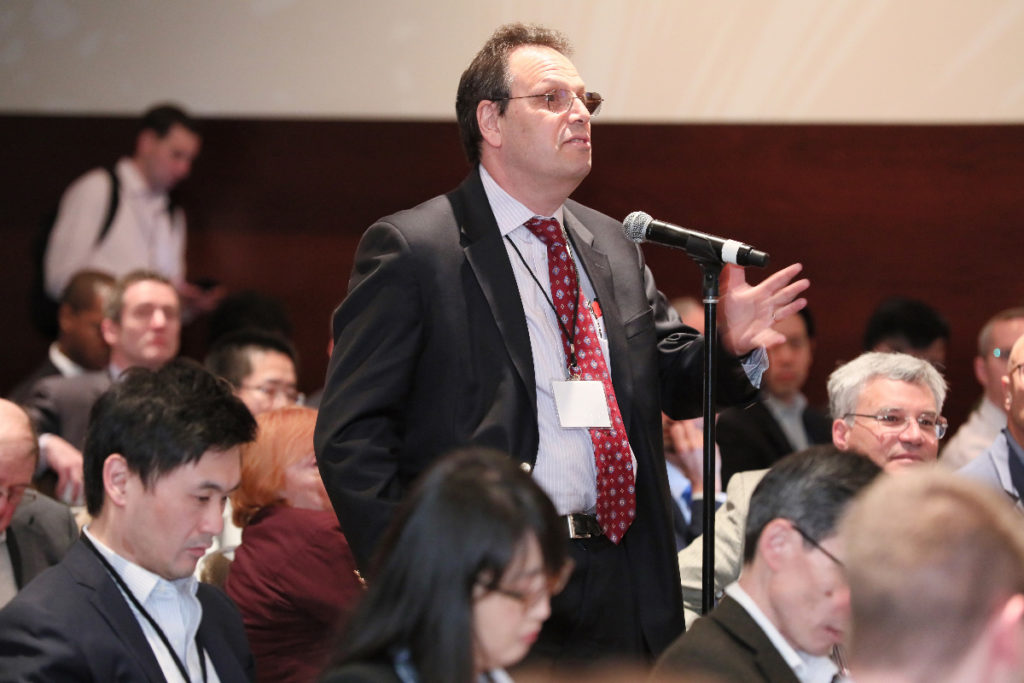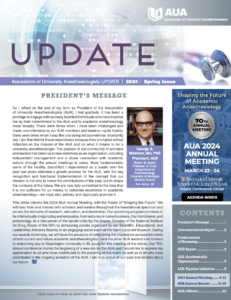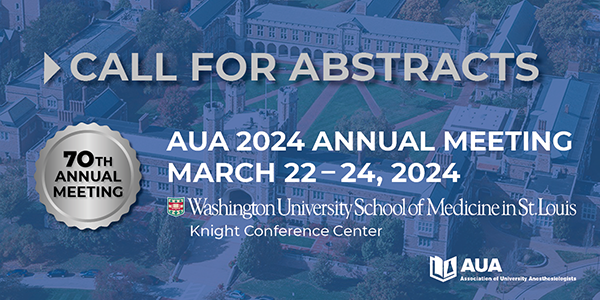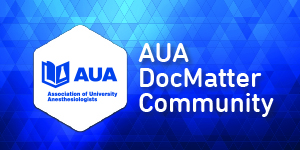Host Program Report from the 2018 AUA Annual Meeting
The Host Program II of the AUA 2018 Annual Meeting, hosted by the Northwestern University Feinberg School of Medicine and The University of Chicago School of Medicine, and organized by Drs. Jeffrey L Apfelbaum, Peter Nagele, and Charles W Hogue, had three terrific speakers with captivating presentations showcasing the depth and diversity of research efforts at both institutions.

Wendy L. Freedman, PhD, John & Marion Sullivan University Professor of Astronomy and Astrophysics, Department of Astronomy and Astrophysics, The University of Chicago Medicine, Chicago, Illinois
Wendy L Freedman, PhD, the John & Marion Sullivan University Professor of Astronomy & Astrophysics from the University of Chicago, led off the host program with a fascinating talk entitled “Our Unexpected Universe”. This entertaining presentation started with a review of our current understanding of the universe, much of it based on the contributions from the Hubble Space Telescope, and then went on to introduce the new Giant Magellan Telescope, currently in construction in the South American Andes, and how this engineering marvel will advance our understanding of the universe. The Hubble Space Telescope changed the perspective of the universe we live in, as it allowed us to look back in time when the first galaxies were forming. The talk was full of interesting detail, such as how the Hubble telescope helped to settle the discussion on the age of our universe and calculated it to be 13.7 billion years. The Hubble Space Telescope advanced our understanding on how the universe is evolving and changing with time. There are 100 billion galaxies in our visible universe, and in each of those galaxies there are 100 billion stars. Hubble helped to calculate how far those galaxies are from us and how fast the universe is expanding. Interestingly, the velocity of galaxies is a function of their distance – the farther the galaxies, the faster they move away from us, a discovery made by Edwin Hubble in 1929. In fact, the Hubble constant measures the current rate at which the universe is expanding. Another startling recent discovery was that most of the matter in the universe is dark matter – a substance which has yet to be fully understood. As good as the Hubble Space Telescope is, it demonstrated that the universe is much greater than we can observe with our current telescopes. Excitingly, the Giant Magellan Telescope (GMT) is currently being built in the Chilean Andes as an international collaborative effort. It will be a massive engineering undertaking: located on a mountain top, 22-stories tall with 7 huge mirrors, each 27-feet in diameter. Strangely, out of all places, the mirrors are being fabricated under the football stadium of University of Arizona. Five of the mirrors have been cast already, and are in the process of being polished. The smoothness of the mirrors is unparalleled, with fluctuations of less than 1/1,000,000 of an inch - such smoothness in the US would mean mountains no larger than couple of inches. The resolution of the GMT will be 10x that of the Hubble Space Telescope and it 20-million times more sensitive than the human eye. As pointed out by Dr. Freedman, if a candle were able to be lit on the moon, the GTM would be able to see it! Dr. Freedman hopes that the scientific adventures with the GMT will start in 2024 when four of the mirrors are expected to be assembled.
The second presentation was by A Vania Apkarian, PhD, Professor of Physiology, Anesthesiology and Physical Medicine and Rehabilitation at Northwestern University Feinberg School of Medicine, entitled “Brain Mechanisms of Chronic Pain and Novel Therapeutic Opportunities”. It was a wonderful and thought-provoking journey questioning our current view of what is chronic pain. Dr. Apkarian started by pointing out that chronic pain represents a huge socio-economic problem, with 20% of the word population suffering from it. It is also tightly related to the opioid epidemic that the US is currently facing. Fundamentally, there are no treatments for chronic pain; there is no management strategy that is any better than any other. In words of Dr. Apkarian, they all equally ineffective due to our incomplete understanding of the science behind chronic pain. The traditional view tries to explain the development and maintenance of chronic pain by the nociceptive circuitry of primary afferents and spinal cord circuits, with the brain passively encoding what is happening in the periphery. Based on this concept, the past efforts to develop chronic pain treatment were focused on peripheral spinal cord targets. Dr. Apkarian then went on to present a series of remarkable brain imaging studies in humans and animals supporting a different view of chronic pain. Here, the brain takes an active role in the process. The key features of this model include 1) characteristics of the brain which determine a propensity for chronic pain; 2) the limbic-emotional circuitry that controls learning, memory and motivation defines the risk for the transition to chronic pain; 3) this circuitry together with injury-related nociceptive signal generates the transitional state which in time creates a 4) new brain state with distinct anatomical and functional properties. In words of Dr. Apkarian: “Chronic pain brain is a state of the brain addicted to nociception.” This highly educational, vivid, and enjoyable lecture concluded by pointing out the many new venues to treatment of chronic pain that this model opens.
The final lecture was given by John Rogers, PhD, Louis Simpson and Kimberly Querrey Professor of Materials Science and Engineering, Biomedical Engineering and Neurological Surgery at Northwestern University Feinberg School of Medicine, entitled “Wireless Skin-Like Sensors of Physiological Status”. It was a truly mesmerizing display of how sophisticated and re-formulated electronic technology can interact more intimately and usefully with human body in the context of human health. Dr. Rogers started by pointing out that the currently popular wearable technology is just nothing more but a rigid, heavy, “blocky” piece of electronic equipment loosely coupled to the body with a strap; good for qualitatively measurement of counting the steps or measuring the activity levels, but unable to really provide an interface that could yield clinically meaningful insights that physicians can observe and interpret in a useful way. What is needed is a “skin-like form of electronics”, a technology that integrates with the skin in a more profound way: able to follow the movements of the skin, to stretch, and be mechanically imperceptible. Such skin-electronics technology would provide an intimate physical interface that could provide sophisticated measurements of skin health as well as use the skin as a window for measurements of the underlying physiological processes. Dr. Rogers lab developed such technology by “slicing” silicon into extremely thin but stretchable filaments. By combining them with soft elements, his lab was able to created “hard-soft-composite-electronic tattoos”, similar to children’s temporary tattoos. They include wireless power harvesting and data transmission with an array of sensors allowing measurement of clinical data, including heart rate, level of hydration, blood pressure, perfusion, temperature, ECG, EEG, EMG, respiratory rate, and many more. He then went on to share two examples how such technology could be used: in the Neonatal ICU, just one of such “skin tattoos” was able to replace the current wire-based monitoring. It was impressive and amazing to see babies without the bulky and movement-limiting wires – just with one small “tattoo” doing all the job while allowing parents to hold their babies without any limitations. The second example was the use of such electronics in adult rehabilitation: here it allowed it to measure speech, swallowing capability, movement of extremities, and sleep quality, thereby providing continuous clinically relevant data on how the patients recover after leaving the hospital, but in a way that is not disruptive. It was breathtaking to see the future of monitoring of clinical vital signs. The future is here, it is wireless, it is small, and it is truly amazing what it can do already.
Overall, the hosts of this year’s meeting, The University of Chicago School of Medicine and the Northwestern University Feinberg School of Medicine, combined their strengths to provide a Host Program Session that was highly entertaining, educational, and inspiring. Thank you!
Wendy L Freedman, PhD, the John & Marion Sullivan University Professor of Astronomy & Astrophysics from the University of Chicago
A Vania Apkarian, PhD, Professor of Physiology, Anesthesiology and Physical Medicine and Rehabilitation at Northwestern University Feinberg School of Medicine
John Rogers, PhD, Louis Simpson and Kimberly Querrey Professor of Materials Science and Engineering, Biomedical Engineering and Neurological Surgery at Northwestern University Feinberg School of Medicine












